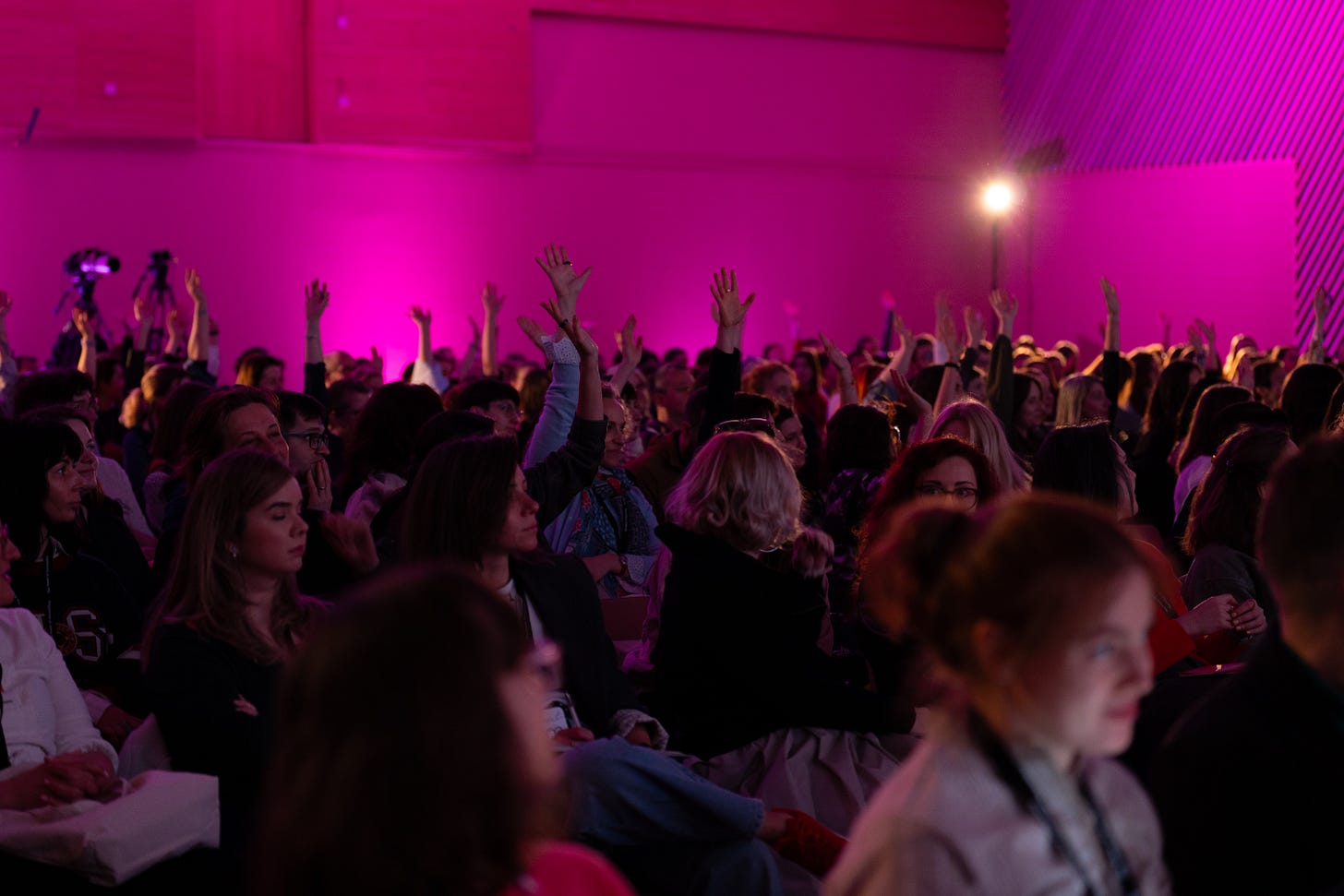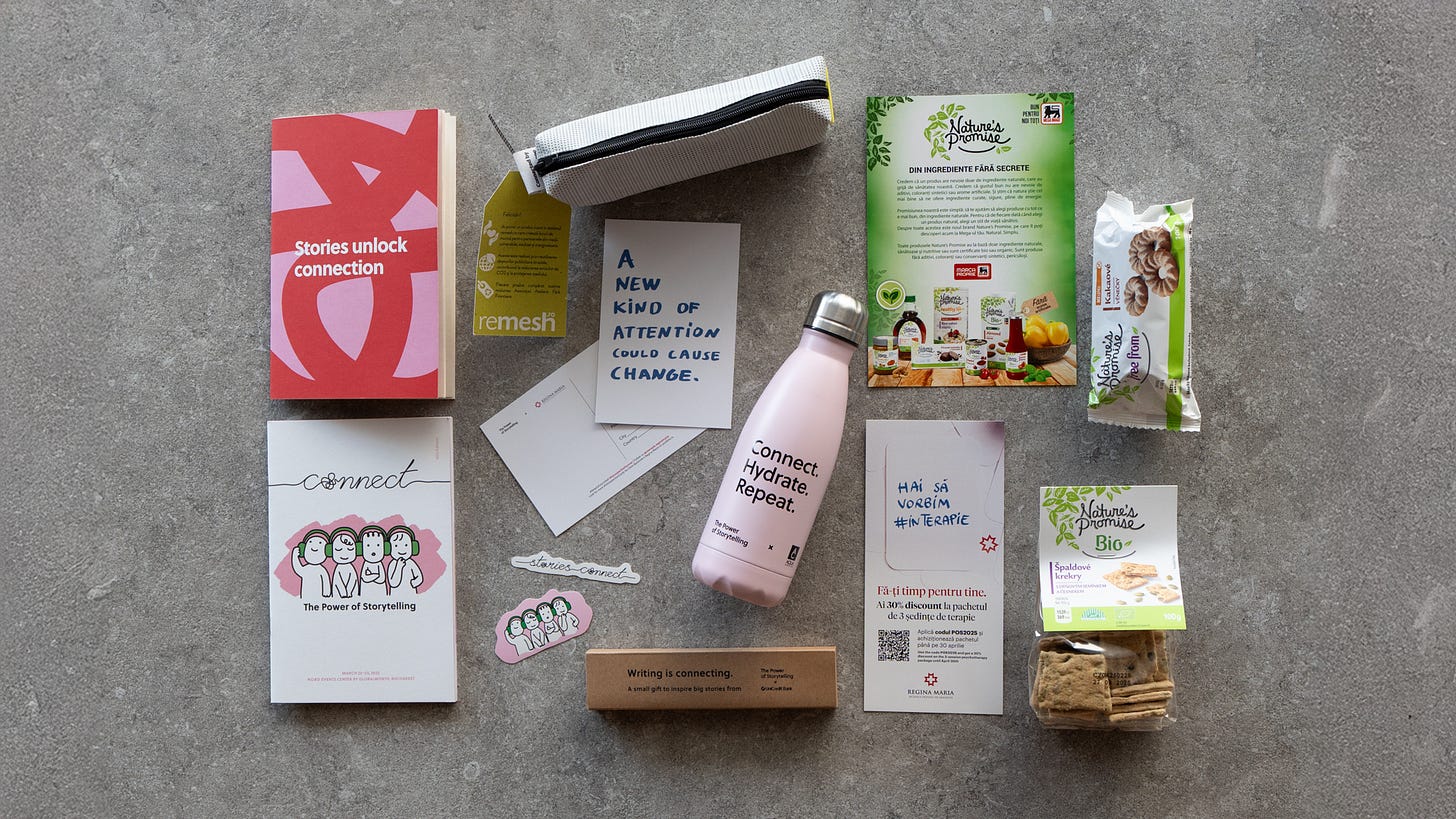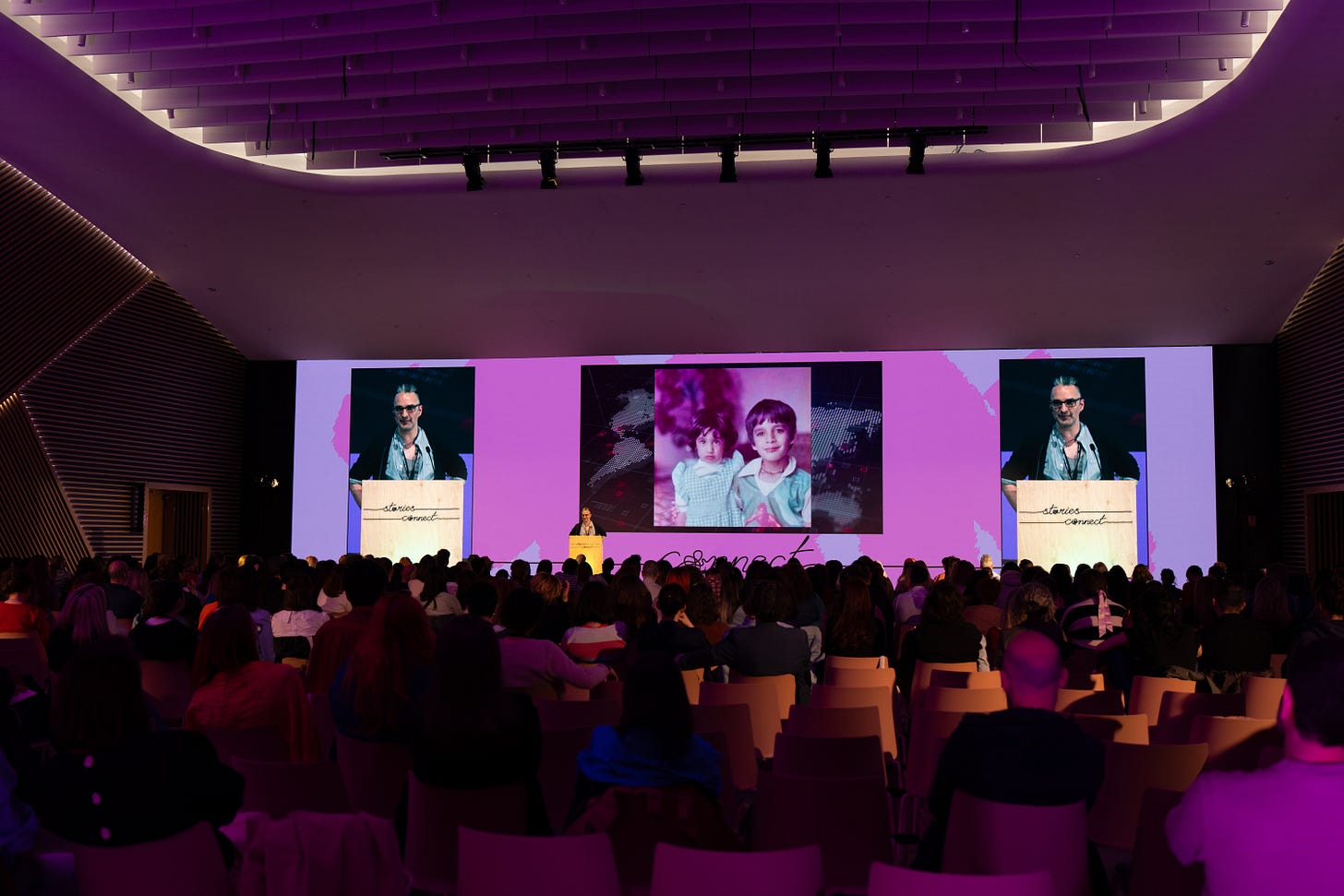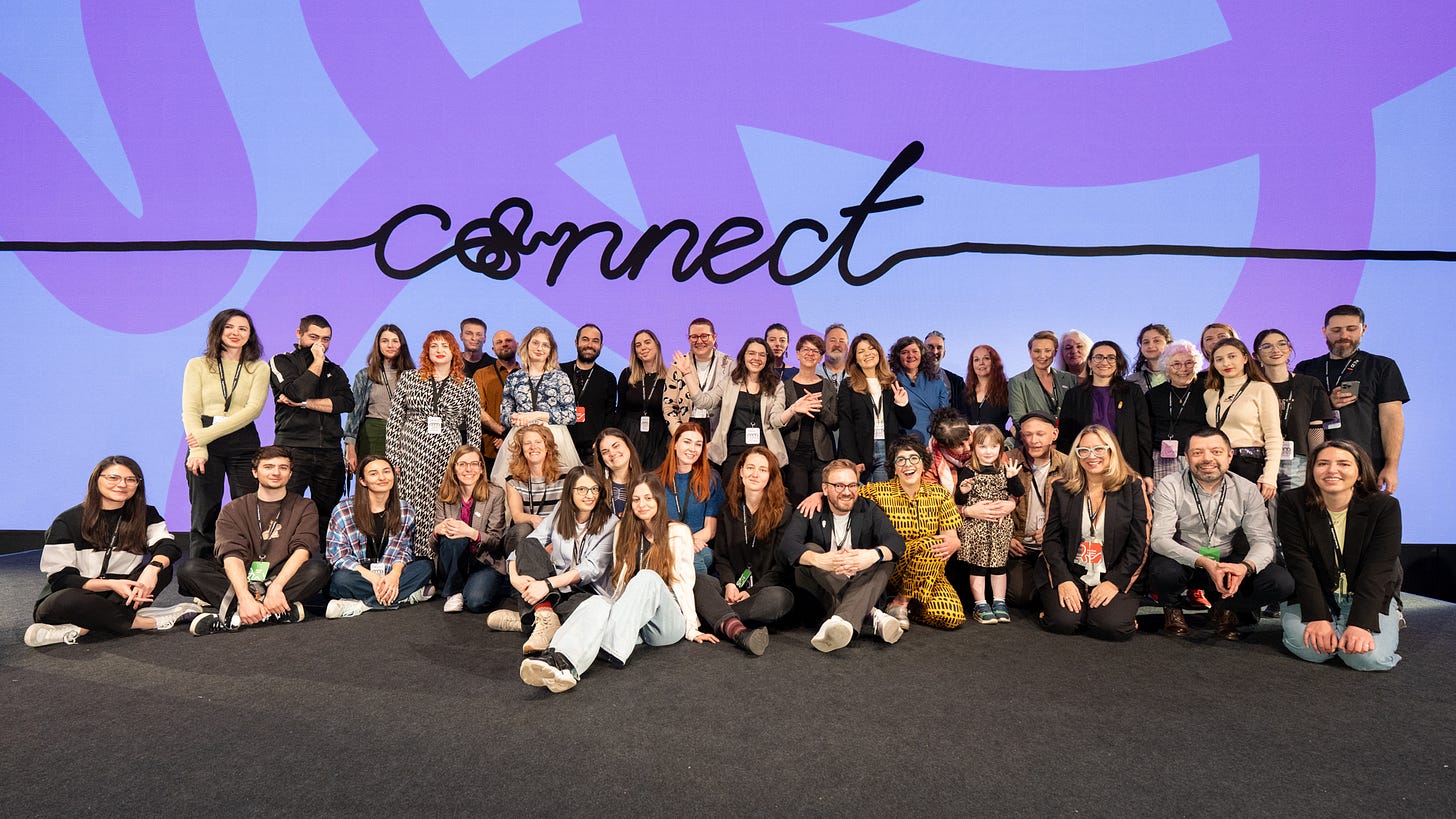I didn’t make it into your inbox last weekend because me and my team were busy with the 10th anniversary edition of The Power of Storytelling. Longtime readers might remember I talked about struggling to find the right solutions for a gathering more than five years in the making.
In the end, it felt like a miracle. So this is a recap, with insights and lessons learned – albeit one that’s coming without having had enough time to sleep and process everything.
A little history first. The event started while I was editing DoR, and the idea was simple: it was 2011, we had been around for a couple of years, and we wanted to help our team and contributors grow as writers. Since we believed the best way to learn was from award-winning narrative nonfiction writers, we reached out to them. My friend and mentor Jacqui Banaszynski said “yes”, and so did another award-winning American journalist, who now writes for The New Yorker. Our plan included a few workshops, journalists only. But when the second guest pulled out, Jacqui suggested we invite a replacement. Instead of one person, we invited three, and the rest is history.
Last time we gathered, in 2019, more than 500 people and almost 20 speakers joined us. Our idea had grown out of our commitment to in-depth and intimate narrative journalism, and was now reaching numerous others who shared our long-lasting belief that well-crafted stories connect people, heal wounds, inspire, lead, and create change.
This is why our audience is largely made up of non-journalists, even though most speakers still come from that world. As a recent participant has just written about this discovery:
I sat down expecting to chat with someone from the media industry. Instead, I found myself next to a midwife who had brought her teenage daughter along. That moment stuck with me. I had assumed storytelling was for us – journalists, writers, podcasters – the professionals. But here was a woman whose job is to bring life into the world, recognizing that stories shape how we connect, communicate, and understand each other.
Midwives, communicators, artists, facilitators, social change activists, entrepreneurs, lawyers, teachers – we talk about the art, craft, and need for stories in a way that benefits everyone.
Alas, we didn’t meet in October 2020, because of the pandemic. Same in 2021. Then the Russian invasion of Ukraine began. And today we do daily geopolitical tight-rope walking on the brink of large-scale conflict – not just Ukraine, but the devastation of Gaza, too –, all while the climate is warming around us, and inequities flourish.
The world needs better stories to hold on to.

As I looked out into that room Saturday morning, I felt I was next to 550 of my closest friends. Bruised, confused, but together. Even hopeful, as naïve as that may sound in a world in chaos. That feeling would continue throughout the weekend, so I thought I’d share 11 personal lessons, paired with takeaways from our mind-blowing lineup of speakers.
1. Hold on to your pencils.
No matter how bad it gets, carry a pencil to tell the story. This is what the soul of this gathering, Jacqui Banaszynski, has been reminding us to do from day one. Yes, we need to tell the story of the autocrats dismantling democracies, but also of the people still living, loving, parenting, and dreaming. “The stories I championed as a writer did not drive traffic”, Jacqui said. “They were always human stories, always emotional, often long. They captured the daily realities of humans navigating life. We can only tell those stories with the trust, the faith, that they matter. They don’t just record bits of history, they record bits of our soul.” So take that pencil, write down the stories, and remember: “There are no metrics that measure the impact on the human heart.”
2. Hope is a choice.
These words were uttered by magazine writer Chris Jones, who recounted a trail of loss in his family, and how it intersects with soccer as a way to remember. I took something extra from it. There are infinite stories in the world about what’s broken. Social media is a machine for criticism, cynicism, and condemnation. The Eastern European cultural landscape often feels like the Olympics of disapproval: nothing is ever good enough.
I’m not interested in scarcity, though; I’m interested in abundance. Stories of what’s not going well are everywhere. Stories of what could go better, of how we could be better, are few and far between. Telling these stories, giving people hopeful experiences, connecting through empathy and love rather than rage – all of it is a design choice.
3. Investigate functional conflict
This is from Amanda Ripley, one of my personal idols, and it connects to the idea above. What do we miss as journalists, as storytellers, when we fall into the trap of becoming fire starters for bad conflict? What happens when we engage in humiliation, binary group identities, and conflict entrepreneurship? Journalists have been doing things this way for years: has it worked?
“We give conflict entrepreneurs the microphone, they say outrageous things and then we repeat it a million times”, Amanda says about much of our work. “Our impulse is journalists is to identify the villain. Then what? Try to figure out what we are really fighting about.”
4. Work hard and show up.
I’m overwhelmed by the feedback and love we received. As someone who often struggles with imposter syndrome, part of me wanted to push away the recognition, as if acknowledging we made something beautiful would be a terrible act of ego-worship. But there is something we shouldn’t worry about acknowledging – everyone worked incredibly hard to make this happen. Magic can’t happen without hard work, and hard work is what I do best. As Jacqui put it: “Throughout my career, I discovered my superpower: It certainly wasn't writing – it still isn’t. It wasn’t confidence – it still isn’t. It was working hard and showing up.”
5. Empathy threatens power structures.
This is a twist on something from Ruxandra Gîdei, my favorite content creator: “Reading threatens power structures built on the illusion of singular truth. It refines our curiosity, it encourages us to stand with contradiction and read between the lines of the world, which we all so direly need.”
What Ruxandra is saying is that we need to expose ourselves to the worlds of others, something Lina Vdovîi, and Radu Ciorniciuc, the co-directors of the award-winning documentary Tata, also touched upon. Empathy is a muscle, is needs training, but it’s what can make the lives of others – especially those we turn away from – a reality. As writer Rachel Louise Snyder put it: “Truth is only threatening when you’ve built your life on lies.”
6. Where is the money?
“The industry doesn’t want us”, podcast editor Alison MacAdam told us. “It’s an industry, and it’s focused on entertainment. This industry is pouring more and more money into content that divides us, that disinforms us.”
Yet you can’t tell complicated stories if you don’t have the money to cover the time people need to spend on such a story. And you can’t organize a conference like ours without a lot of money: around 240.000 euros it turns out (according to our latest math).
Our revenues were around 230.000 euros, so technically we lost money – we are covering the extra 10.000 from funds we raised for various story experiments, which this is now a part of. Of course you can laugh at us for being bad with money and planning – we do, too. But also ask yourself how you’d have done it. We didn’t want to pass the cost onto the audience, so we kept a ticket at 150 euros (still pricey for journalists, NGO folks, artists), the same it sold for in 2019, even though costs are almost double today. We also hit a ceiling on fundraising. (If you think commercial sponsors are tripping over themselves to back a conference like ours, think again.) And we didn’t want to cut into the experience, so yes, we spent money on wonderful tote bags, water bottles, pens, and good food.
7. Go beyond me-me-me
The theme of this year was connect – both as a response to the loneliness around us, but also to an intentional withdrawal into the self, sometimes bordering on self-absorption. Therapist Raluca Anton tackled this idea on stage: we can’t fix ourselves by isolating. We function in community. We grow in community. We heal in community.
“The individual perspective says our problems lie within ourselves”, Raluca said. “But they also lie in the space between us. So it’s not enough to address what’s happening inside, we also have to address what’s happening between us.” More than anything, this is why people enjoyed the conference: because they were able to share something with others, to go through an experience with strangers. We did our best to support this: we matched people for group dinners the night before the conference started and we also ended with the lights closed and everyone dancing to Robyn’s Dancing on my Own – which will become a core memory for me.
8. We live in storyworlds.
What we’ve created over the weekend was, as sci-fi writer Arkady Martine put it, a storyworld. A storyworld is a space, place and time we inhabit, and we follow its rules and values. It’s a personal reality. Ours happen to value generosity, care, justice, vulnerability. Plus good coffee.
We all live in storyworlds we think are the only ones out there – worse, we sometimes think ours might be among the best ones. And then, our storyworld collides with others.
This was something I wanted to leave people with as the days wrapped up. The conference provided an escape, it was a small luxury, a gift: the chance to experience a high along with other people in the same storyworld. But the real challenge starts the next day, and continues every day after that: what will you do when your storyworld is in tension with others? Will you live up to your stated values? Or will you try to impose your will on others?
9. Grow in increments
One of my favorite quotes is: courage is a series of small steps. Chris Jones said a version of that this weekend, referring to happiness: “Happiness can disappear in an instant. And it comes back in increments. You can’t win it back all at once.”
We honestly never believed we would do the conference again, especially after DoR closed. It seemed too costly, too complicated, too big. And then one day, almost a year ago, UniCredit Bank, who have been with us since the early days, said “Yes!” to a funding proposal. We started by securing a core team of two, then three, then four, and so on. If there was happiness and joy in that room, it’s because we took it one step at a time and did our best at each one.
10. Center care
Care has been an important concept in our journalism and event making, and it was at the heart of Shirish Kulkarni’s speech about what would we invent if journalism didn’t exist?
“It would start with care: for ourselves and for others”, Shirish said. “It would focus on generosity: the stories would be trauma informed rather than traumatic, they would focus on healing rather than pain. It would work towards justice. And we’d finally be able to hold complexity.”
This is not just about journalism: this can be about how you care for a student in class, how you care for a patient, how you treat a customer. It’s what makes people feel seen. To me, this is what this conference is about and, in full disclosure, it’s what I told the team in a thank you email:
Don’t take what we've built together for granted – this is special. It’s a kind sacrifice, and people repay it with personal transformation.
You have speakers on stage saying The Power of Storytelling changed their lives. You have people in the audience saying the same.
This magic comes from the emails we sent, the badges we made, the pencils we bought, the zines we folded, the airport runs we did, the spreadsheets we filled out, the waters we arranged. Every word spoken on stage, the spectacular LED screen, the photos and videos – none of it would have landed the same without the care we put into how we hosted.
11. Don’t wait. Do it yourself.
Rhiannon White is a theater-maker from Wales who co-founded a site-specific company whose shows are built on the experiences of the local community. They don’t have a venue, so they make do. They have made DYI an ethos. She just wrapped up a book on their work that closes with their principles. The last two are: “Work with what you have. Build on what is already there”, and “Don’t wait for permission. Do it yourself!”
You don’t need to wait to fundraise 200K to do something for others. You don’t need hundreds of people in the audience and dozens of people on stage. You can start small, work hard, prioritize people’s experience. Remember that, as dark as things seem, people want to belong to a storyworld, crave connection, and need a sense of shared purpose.
SIDE DISHES:
The only extra things I’ll leave you with are some extra takeaways by our team: you can read about day one here, and about what happened on day two here. OK, and this dance playlist that Jennifer Brandel and Mara Zepeda curated from songs submitted by the participants.





I also wished to be there but this time could not afford the conference ticket. Your words fill me with hope and i feel blessed that there are still people like you and the team and the audience and the guests ..in the world. Please count on me for helping with fundraising for the next event.
All of you make this wotld a better place! Thank you for writing about it. Sending my love and appreciation!
Beautiful 🙏